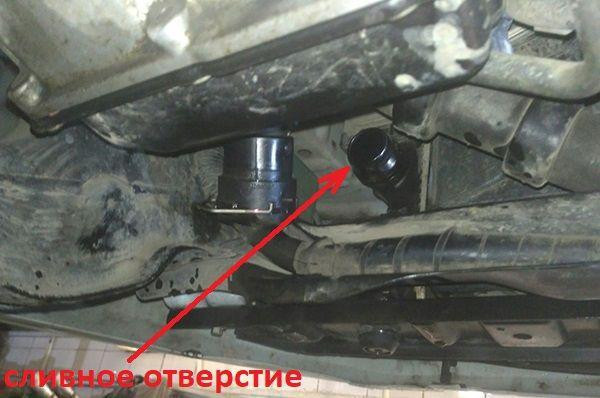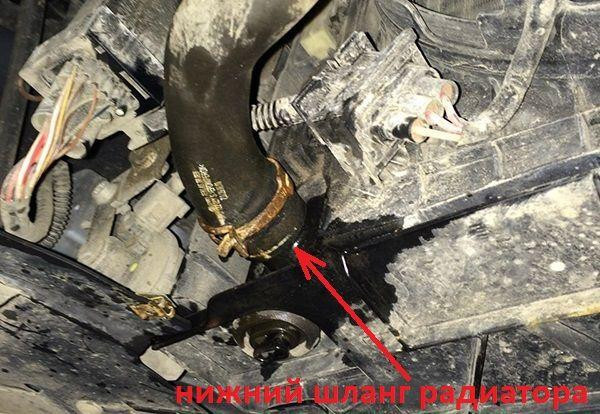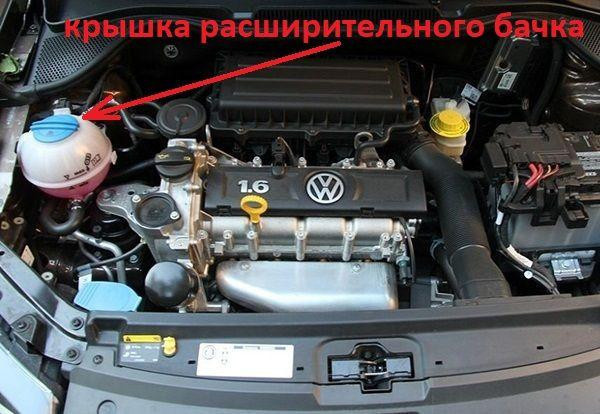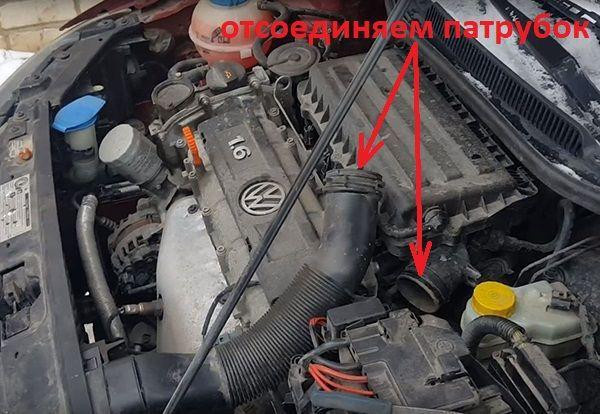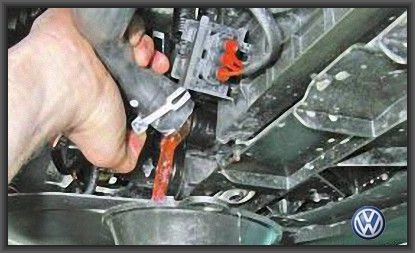
Replacing antifreeze Volkswagen Polo Sedan
Content
Many VW Polo Sedan owners do their own maintenance because they think the car is easy to maintain. You can also replace antifreeze with your own hands, if you know some of the nuances.
Stages of replacing the coolant Volkswagen Polo Sedan
Like most modern cars, this model does not have a drain plug on the cylinder block. Therefore, the liquid is partially drained, after which flushing is required to completely remove the old antifreeze.

This model is very popular not only in our country, but also abroad, although it is produced there under a different name:
- Volkswagen Polo Sedan (Volkswagen Polo Sedan);
- Volkswagen Vento).
In our country, gasoline versions with a 1,6-liter naturally aspirated MPI engine have gained popularity. As well as 1,4-litre TSI turbocharged models. In the instructions, we will analyze the correct replacement with our own hands, in the Polo Sedan version 1.6.
Draining the coolant
We install the car on a flyover, so that it is more convenient to unscrew the plastic cover from the engine, it is also protection. If a regular one is installed, then most likely it will be necessary to unscrew 4 bolts. Now access is open and you can start draining antifreeze from our Polo Sedan:
- From the bottom of the radiator, on the left side towards the car, we find a thick hose. It is held by a spring clip, which must be compressed and moved (Fig. 1). To do this, you can use pliers or a special extractor.

- We substitute an empty container under this place, remove the hose, the antifreeze will begin to merge.
- Now you need to open the cover of the expansion tank and wait until the liquid is completely drained - about 3,5 liters (Fig. 2).

- For the most complete drainage of the cooling system, it is necessary to apply pressure to the expansion tank using a compressor or pump. This will pour out about 1 liter of antifreeze.
As a result, it turns out that about 4,5 liters are drained, and as we know, the filling volume is 5,6 liters. So the engine still has about 1,1 liters. Unfortunately, it cannot be simply removed, so you have to resort to flushing the system.
Flushing the cooling system
We will rinse with distilled water, so we install the removed hose in place. Pour water into the expansion tank 2-3 centimeters above the maximum mark. The level drops as it warms up.
We start the Volkswagen Polo engine and wait until it warms up completely. Full heating can be determined visually. Both radiator hoses will be evenly hot and the fan will switch to high speed.
Now you can turn off the engine, then wait a bit until it cools down and drain the water. Washing off the old antifreeze at a time will not work. Therefore, we repeat the flushing 2-3 more times until the drained water is clean at the outlet.
Filling without air pockets
Many users, replacing antifreeze with a Volkswagen Polo Sedan, are faced with the problem of air congestion. This implies the operation of the engine at high temperatures, and cold air can also come out of the stove.
To avoid such problems, fill the coolant correctly:
- It is necessary to disconnect the branch going to the air filter in order to get to the temperature sensor (Fig. 3).

- Now we take out the sensor itself (Fig. 4). To do this, pull the plastic half ring towards the passenger compartment. After that, you can remove the temperature sensor.

- That's all, now we fill in antifreeze until it flows from the place where the sensor was located. Then we put it in place and install the retaining ring. We attach the pipe that goes to the air filter.
- Add coolant to the correct level in the reservoir and close the cap.
- We start the car, we wait for full warming up.
By pouring antifreeze in this way, we avoid an air lock, which will ensure the operation of the engine in normal mode, preventing overheating. The stove in heating mode will also emit hot air.
It remains to check the fluid in the tank after the engine cools down, if necessary, top up to the level. This check is preferably carried out the next day after replacement.
Frequency of replacement, which antifreeze to fill
Recently released models use modern antifreeze, which, according to the manufacturer, does not require replacement. But motorists do not share such optimism, as the liquid sometimes changes color to red over time. In previous versions, the coolant had to be replaced after 5 years.
To refuel the Polo Sedan, the manufacturer recommends the original Volkswagen G13 G 013 A8J M1 product. Complies with the latest homologation TL-VW 774 J and comes in lilac concentrate.
Among analogues, users distinguish Hepu P999-G13, which is also available as a concentrate. If you need ready-made antifreeze, the VAG-approved Coolstream G13 is a good choice.
It should be understood that if the replacement is carried out with flushing the cooling system, then it is better to choose a concentrate as the liquid to be filled. With it, you can achieve the correct ratio, given the non-drained distilled water.
How much antifreeze is in the cooling system, volume table
| Model | Engine power | How many liters of antifreeze is in the system | Original liquid / analogues |
|---|---|---|---|
| Volkswagen Polo Sedan | 1.4 gasoline | 5.6 | VAG G13 G 013 A8J M1 (TL-VW 774 D) |
| 1.6 gasoline | Hepu P999-G13 | ||
| Coolstream G13 |
Leaks and problems
Changing the coolant is necessary not only in case of loss of properties or discoloration, but also when troubleshooting problems associated with draining the liquid. These include replacing the pump, thermostat, or radiator problems.
Leaks are usually caused by worn hoses, which can crack over time. Sometimes cracks may appear in the expansion tank, but this is more common in the first versions of the model.
